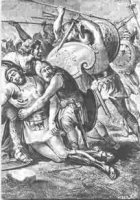
Worksheets and No Prep Teaching Resources
Reading Comprehension Worksheets
Ancient Rome

Ancient Rome
 Worksheets and No Prep Teaching Resources Reading Comprehension Worksheets Ancient Rome |
 Ancient Rome |
| edHelper's suggested reading level: | grades 6 to 8 | |
| Flesch-Kincaid grade level: | 7.11 |
|
Spartacus
By Vickie Chao |

|
 1 Ancient Rome had a lot of marvels. Back in its heyday, the Romans put up many spectacular structures. Some of them still remain standing today. As we admire the civilization that ancient Rome left behind, we must keep one thing in mind. Rome's glory was built largely on the backs of countless slaves.
1 Ancient Rome had a lot of marvels. Back in its heyday, the Romans put up many spectacular structures. Some of them still remain standing today. As we admire the civilization that ancient Rome left behind, we must keep one thing in mind. Rome's glory was built largely on the backs of countless slaves. |
Create Weekly Reading Books
Prepare for an entire week at once! |
| Leave your feedback on Spartacus (use this link if you found an error in the story) |
 |
Ancient Rome
|
 |
Social Studies
|